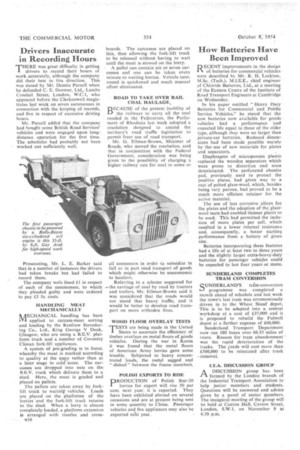Drivers Inaccurate in Recording Hours
Page 44

If you've noticed an error in this article please click here to report it so we can fix it.
THERE was great difficulty in getting I drivers to record their hours of work accurately, although the company did their best in this direction. This was stated by Mr. Dennis Purse11 when he defended C. E. Dormer, Ltd., Lambs Conduit Street, London, W.C.1, who appeared before the Clerkenwell magistrates last week on seven summonses in connection with the keeping of records, and five in respect of excessive driving hours.
Mr. PurseII added that the company had bought some British Road Services' vehicles and were engaged upon longdistance operation for the first time. The schedules had probably not been worked out sufficiently well.
Prosecuting, Mr. L. E. Barker said that in a number of instances the drivers had taken breaks but had failed to record them.
The company weie fined £1 in respect of each of the summonses, to which they pleaded guilty and were ordered to pay £5 5s. costs.
HANDLING MEAT MECHANICALLY NAECHANICAL handling has been /VI applied to carcass-meat sorting and loading by the Renfrew Stevedoring Co., Ltd., King George V Dock, Glasgow, who are using a B.E.V. platform truck and a number of Coventry Climax fork-lift appliances.
A system of pre-grading is in force, whereby the meat is marked according to quality at the qtkay rather than at a later stage in cold store. The carcasses are dropped into nets on the B.E.V. truck which delivers them to a shed. Here, the meat is graded and placed on pallets.
The pallets are taken away by forklift truck to waiting" vehicles. Loads are placed on the platforms of the lorries and the fork-lift truck returns to the shed. When a lorry is almost completely loaded, a platform extension is arranged with trestles and cross 11 1 0
boards. The carcasses are placed on this, thus allowing the fork-lift truck to he released without having to wait until the meat is stowed on the lorry. A pallet can contain six or seven carcasses and one can be taken every minute to waiting lorries. Vehicle turnround is quickened and much manual effort eliminated.
ROAD TO TAKE OVER RAIL COAL HAULAGE,
BECAUSE of the present inability of the railways to carry all the coal needed in the Federation, the Parliament of Rhodesia last week adopted a resolution designed to amend the territory's road traffic legislation to permit freer use of road transport.
Mr. G. Ellman-Brown, Minister of Roads, who moved the resolution, said that in conjunction with the Federal Government, consideration was being given to the possibility of charging a higher railway rate for coal to some or all consumers in order to subsidize in full or in part road transport of goods which might otherwise be uneconomic to hauliers.
Referring to a scheme suggested for — the carriage of coal by road by tractors and trailers, Mr. Ellman-Brown said it was considered that the roads would not stand that heavy traffic, and it would be better to develop road transport on more orthodox lines.
WOOD FLOOR OVERLAY TESTS TESTS are being made in the United A States to ascertain the efficiency of timber overlays on metal floors of goods vehicles. During the war in Korea it was found that the metal floors of American Army lorries gave some trouble. Subjected to heavy concentrated loads, the metal sagged and "
dished" between the frame members. POLISH EXPORTS TO RISE
PRODUCTION of' Polish Star-20 lorries for export will rise 50 per cent. next year, it is reported. They have been exhibited abroad on several occasions and are at present being sent in some quantity to China. Passenger vehicles and fire appliances may also be exported next year.




























































































